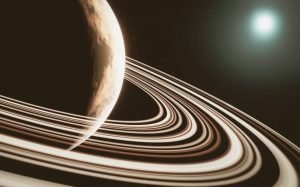A new planet with rings has been discovered in the solar system

 Scientists from the University of Sheffield have identified a new planet with rings in the solar system. The results of the work are described in the journal Nature, reports cnn.com.
Scientists from the University of Sheffield have identified a new planet with rings in the solar system. The results of the work are described in the journal Nature, reports cnn.com.
We are talking about the dwarf planet Quaoar, located at the very edge of the solar system. The object was first discovered back in 2002, it is half the size of Pluto and orbits the Sun behind Neptune.
Now, with the help of modern HiPERCAM equipment, installed on the world’s largest optical telescope Gran Telescopio Canarias (GTC), the rings have been discovered around the planet.
At the same time, Quaoar rings are too small and weak to be seen in the picture. The discovery was made thanks to the observation against the background of the shadow from the star, which arose when Quaoar obscured the luminary during its rotation cycle.

The event lasted less than a minute, but during that time the rings created static in the light that indicated their presence.
Ring systems are not very common in the solar system. The most famous are the rings of Saturn and Jupiter. The uniqueness of Quaoar lies in the fact that it is located at a distance of more than seven planetary radii.
This is more than twice what was previously considered the maximum distance according to the “Roche limit” – the boundary within which ring systems can exist. For example, the rings of Saturn are located within three planetary radii.
Professor Vik Dhillon, of the University of Sheffield’s physics and astronomy department, said: “It was unexpected to discover this new ring system in our solar system.
“And it was doubly unexpected to find the rings so far out from Quaoar, challenging our previous notions of how such rings form.”
A new study is forcing scientists to rethink ring formation theories.
Hey explorer! Every article you read on Anomalien is made possible thanks to the generous donations of our supporters. If you want to help us continue our work, we invite you to make a donation. Make 👽 happy!Follow us on Instagram, Twitter and Telegram for interesting and mysterious bonus content!




